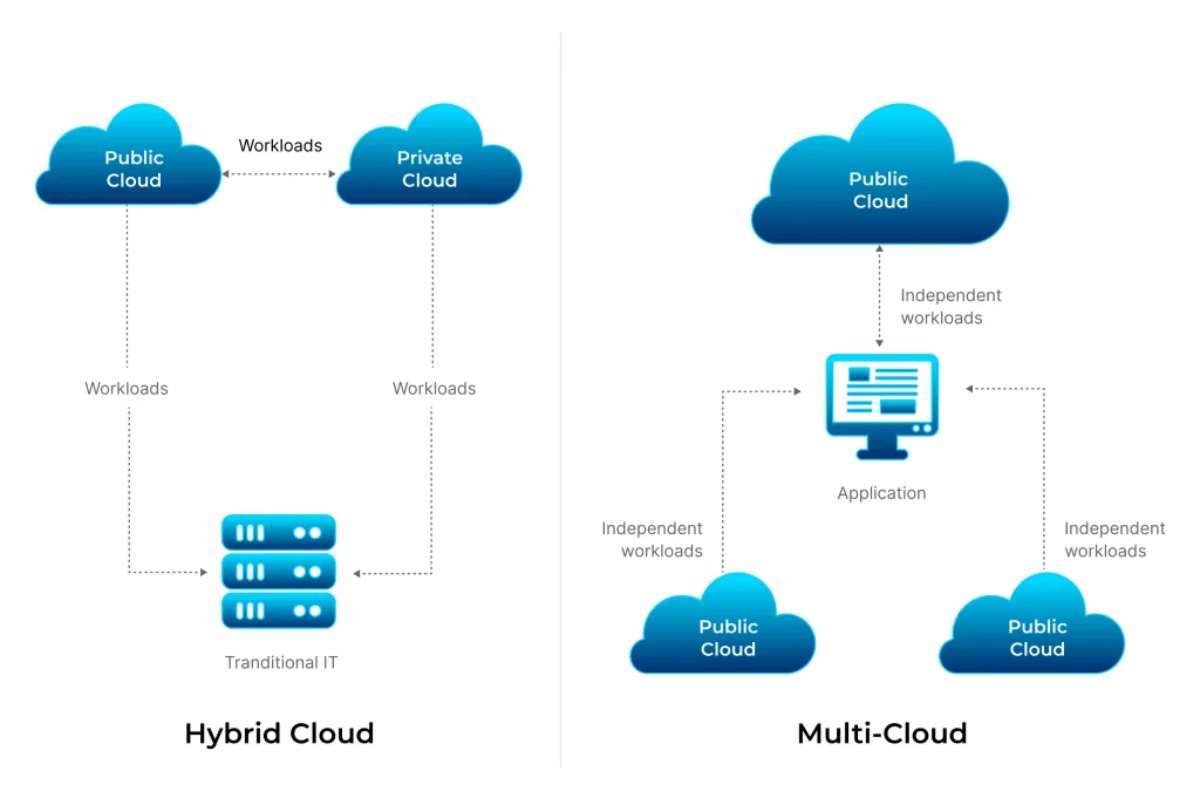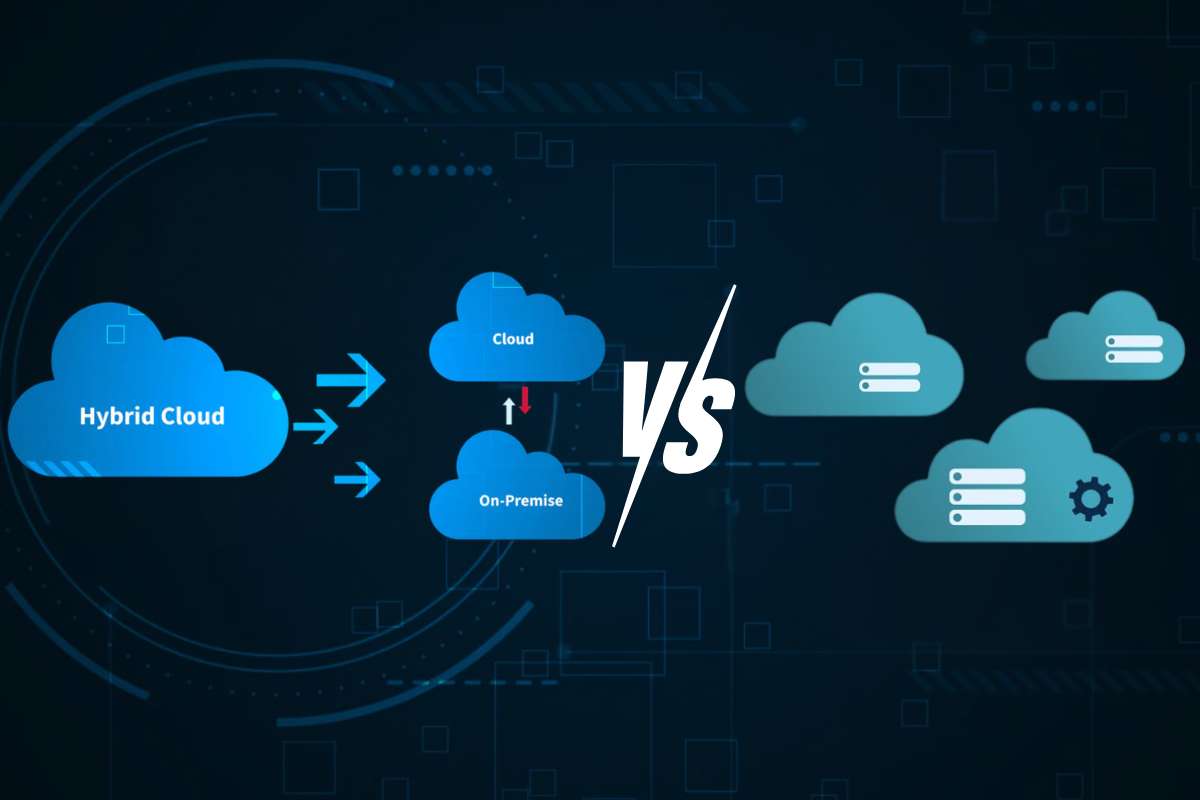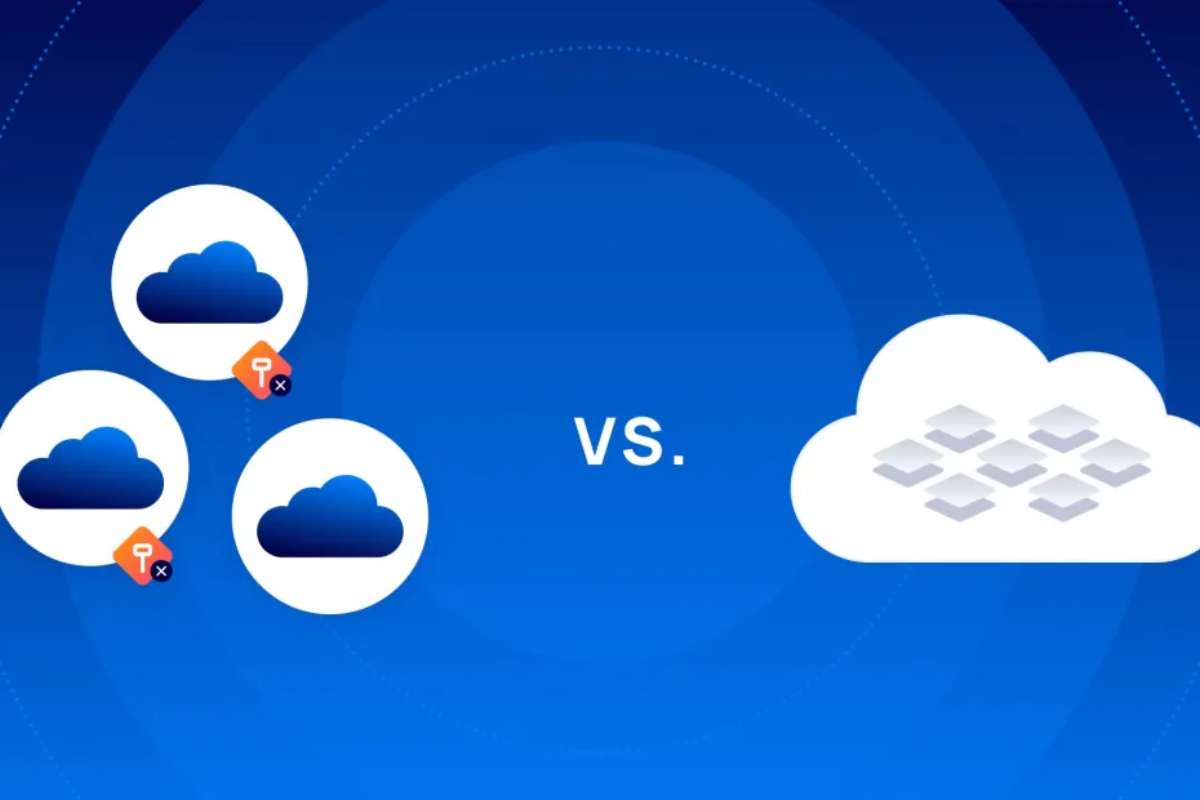In cloud computing, two terms that often become the source of lively discussion are “Hybrid Cloud vs Multi Cloud”. While they may appear similar at first. However, both ideas showcase different cloud environments upon closer examination. They have different architectures and different primary philosophies. And the debate around Hybrid cloud vs Multi Cloud continues to have experts choose which one offers the best benefits.
Are you looking for the powerful control of an on-premise set-up? That is comfortably tied with the flexibility of public clouds. Along with boundless freedom to mix best-of-breed services from various public cloud providers and avoid seller lock-in at all costs?
Then, let’s explore the differences and benefits between Hybrid Cloud vs Multi Cloud. This article will help guide you along this important path for your organization.
What are hybrid Cloud and Multi Cloud?
Imagine blending two worlds, the security of your own computer systems, like a company’s private data center. With the power and flexibility of the internet (public cloud). That’s what a hybrid cloud does. Some businesses use it because moving everything to the public cloud can be too expensive or complicated. Others prefer to keep sensitive information safe on their own systems. While using the public cloud to handle bigger tasks that need more space or speed.
Using different public cloud services for different jobs, like one for storing data and another for managing user logins. That’s called a multi cloud approach. And if you mix this setup with your own private systems, it becomes a hybrid cloud too.
Architectural Differences of Hybrid Cloud vs Multi Cloud:

Imagine you’re using different storage spaces for your digital stuff, some in your school locker (private) and some in the cloud (public). That’s kind of how hybrid cloud works. It mixes your own on-site systems (like for login or storing important data) with at least one public cloud service. Everything works together in a coordinated way.
Now think of multi cloud like using several different online services for different tasks. One for photos, one for videos, and another for documents. This setup uses only public cloud providers, but from different companies. It helps you avoid depending too much on just one company and lets you choose the best tools for each job.
Every hybrid cloud is technically a type of multi cloud, because it uses more than one cloud. But not every multi-cloud is a hybrid, because it doesn’t include private or on-site systems.
The hybrid cloud is about combining private and public tools. While multi-cloud is about mixing public tools from different companies. Both give you more control, flexibility, and better ways to manage your data..
Decoding the Debate of Hybrid Cloud vs Multi Cloud: Key Difference

Here’s a difference table comparing Hybrid Cloud and Multi-Cloud:
| Feature | Hybrid Cloud | Multi-Cloud |
| Definition | Combines private (on-premises) and public cloud environments, allowing data/apps to move seamlessly. | Utilizes multiple public cloud services from different providers. No inherent private cloud component required. |
| Core Components | Private cloud (on-premises datacenter) and at least one public cloud. | Multiple public clouds (e.g., AWS, Azure, Google Cloud). |
| Primary Driver | Regulatory/data sovereignty compliance, maximizing on-premises investments, addressing latency, scaling on-demand. | Leveraging best-of-breed services from different providers, avoiding vendor lock-in. |
| Flexibility | High, allows scaling on-premises to public cloud, retaining sensitive data on-premises. | High, allows choosing services from various providers. This focuses on interoperability and unified development practices across clouds. |
| Control | Greater control over sensitive data and workloads in the private cloud. | Focus on managing security posture and integrating policies across multiple public cloud environments. This may face challenges with inconsistent operational models. |
| Scalability | Seamlessly scales on-premises infrastructure to the public cloud for demand spikes. | Scalability within and across multiple public clouds. |
| Cost Efficiency | Eliminates large CAPEX for short-term demand spikes. Pay-as-you-go for temporary public cloud use; potential for off-site DR/backup cost reduction. | Focus on optimizing costs across different public cloud offerings. It aims to avoid vendor lock-in, which can impact pricing negotiations. |
| Security | Integrated cross-platform security, unified compliance across private and public clouds, and retains highly sensitive data on-premises. | Managing security posture across diverse public cloud environments can be challenging, requiring careful data strategy to meet compliance (PCI, HIPAA, GDPR) using availability zones/regions. |
| Compliance/Data Sovereignty | Strong advantage due to the ability to keep sensitive data on-premises, meeting stringent regulatory demands. | Requires careful planning and utilization of public cloud features (e.g., regions, availability zones) to ensure data residency and compliance. |
| Disaster Recovery (BCDR) | A compelling option for public cloud BCDR for non-restricted on-premises workloads, leveraging public cloud security, scale, and ease of recovery. | Public cloud BCDR strategies are key for protecting data across multiple public clouds, but require careful data placement to meet regulatory demands. |
| Operational Focus | Modernizing and protecting mission-critical applications and data. This is bringing cloud services on-premises for regulated industries. | Visibility into all infrastructure and applications (single pane of glass). Difficulty integrating on-premises policies with cloud infrastructure. And unifying development practices across diverse cloud platforms. |
| Complexity | Managing integration between private and public clouds, ensuring consistent policies. | Orchestration and monitoring across different public cloud providers. They are managing diverse skill sets and achieving consistent interoperability. |
Case Study: Multi-Cloud and Hybrid Cloud Guide

In the tech world, the debate between Hybrid Cloud vs Multi-Cloud is a big decision, not just about names, but about how a business runs and grows. This easy guide from the U.S. General Services Administration breaks it down. Hybrid Cloud means a mix of local computers (on-premises) with cloud services. Multi-Cloud means using different cloud providers at the same time, without depending on any local setup. The case study shows that both choices come with their own pros and cons, like cost, speed, security, and how easy they are to manage. Understanding these differences helps organizations pick the right path.
Source: https://www.cio.gov/assets/resources/Multi-Cloud%20and%20Hybrid%20Cloud%20Guide_v4_Final.pdf
Conclusion:
The debate of Hybrid Cloud vs Multi Cloud is more than a semantic problem; it’s a decision point for contemporary businesses. The decision needs availability of control, compliance, flexibility, and cost savings (ICTS).
You can choose to use both your own computer systems (on-premises) and a public cloud together; this is called a hybrid setup. It gives you the best of both worlds: strong control and flexibility. Or, you might go with a multi cloud strategy, where you use different public cloud services from various companies. This way, you’re not locked into just one provider, and you get more freedom to pick what works best for each part of your work.
The most important thing? Knowing the difference between the two. As more companies move to the cloud, there isn’t one perfect solution. The best choice is the one that fits your goals, keeps your data safe, and helps your business grow smartly.
FAQ:
1. What are the 4 types of cloud computing?
The four main types of cloud computing deployment models are public cloud, private cloud, hybrid cloud, and community cloud. The four main types of cloud computing deployment models are public cloud, private cloud, hybrid cloud, and community cloud. These models differ in how the cloud infrastructure is set up and managed. And affecting factors like cost, security, and accessibility.
2. What is the difference between a Hybrid Cloud vs Multi Cloud?
However, cloud computing is continually evolving, and cloud-service providers (CSPs). It may offer hybrid clouds that combine features of both the public and private models. Community clouds are a recent variant of hybrid clouds. They are built to serve the specific needs of different business communities.
3. What is an example of a hybrid cloud?
One example is a company using a public cloud for general computing and storage. While keeping sensitive customer data in a private cloud for security and compliance reasons.
Also Read :- Cloud Migration in 2025: Critical, Tools, Risks & Companies






